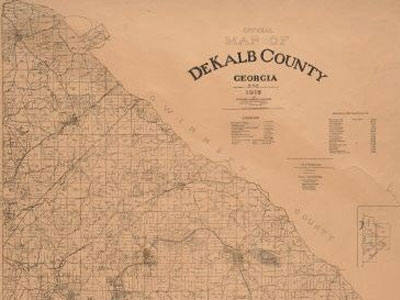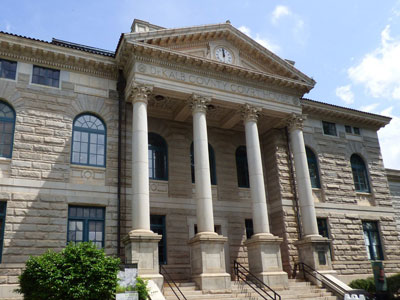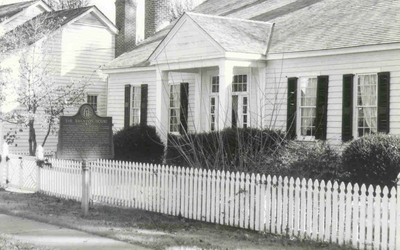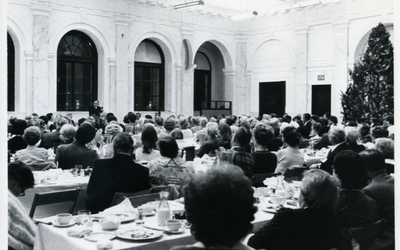EXHIBITS & HISTORY
DeKalb County History
The land that we now call Georgia was once the ancestral homeland to both the Cherokee Nation and the Muscogee (Creek) Nation. The Creek Confederacy, now known as the Muscogee (Creek) Nation, consisted of a union of several groups – Muscogees being the largest, Hitchitees, Yuchis, and others. Sometime in the 1700s, Europeans began calling them “Creeks” because they resided near waterways. They lived in tribal towns all through middle and south Georgia and in Alabama. The Cherokee Nation inhabited parts of northern Georgia and Alabama, southern Tennessee, and western North Carolina.
In order to preserve the well-being of its people, the two nations slowly began to assimilate and cede some of their land in an effort to appease the burgeoning population of incoming settlers. The Cherokee and Muscogee (Creek) Nations were two of the “Five Civilized Tribes,” a term coined by European settlers, identifying southeastern tribes that attempted to conform to European culture and society in order to survive and maintain peace. Unfortunately, the thirst for land and money was too great, and the nations were forced to give away their lands until there was nothing left.
There are eight confirmed land lotteries directly resulting from both the Creeks and Cherokees ceding their land: 1805, 1807, 1820, 1821, 1827, 1832 (two lotteries occurred), and 1833.
The 1821 land lottery, which raffled off land taken from the Creeks, resulted in the formation of Henry, Fayette and Gwinnett Counties, from which DeKalb County would eventually be formed. The General Assembly of the State of Georgia appointed five commissioners who picked land lot 246 in the 15th militia district as the county site.
DeKalb County was established in 1822 as Georgia’s 56th county and is situated on a natural ridge that runs between Atlanta and Athens, the Continental Divide. The southern boundary is the South River and the northern boundary is the Hightower Trail, a trading path used by Indigenous Peoples from across the southeast.
The county has 269 square miles and was named after Baron Johann de Kalb, a native of Germany and self-proclaimed baron who aided the colonists in their fight for independence. The county seat was named for Stephen Decatur, a naval hero in the War of 1812. Neither man ever set foot in DeKalb County. Both surnames were popular for “new” place names in this time period – over 30 cities and counties in the United States are named for these men.
DeKalb was already organized into militia districts with justices of the Inferior Courts and justices of the peace retaining their offices. Captains of the militia districts often served as judges and tax collectors for the districts as well. Some of these early militia districts included the Diamond District, the Browning District and the Shallowford District. The City of Atlanta, in its infancy and until 1853 when Fulton County was created, was entirely in DeKalb County.
As the Muscogee (Creek) were slowly being pushed out, the settlers who came into DeKalb were of English, Scotch, and Irish descent coming from Virginia, the Carolinas, and Europe. They were subsistence farmers who were not highly educated and usually lived in log cabins.
Decatur was incorporated as the county seat on December 10, 1823. Its location was a trading post at the intersection of two Native trails.
In July of 1864, some of the battle of Atlanta actually took place in DeKalb County around the courthouse and along what is now DeKalb Avenue.
Chief of the industries during the early years in DeKalb were granite quarrying, farming, dairy farming and cotton mills and grain mills. Land near the South River produced 1,000 or more pounds of cotton per acre, and the county was one of the largest milk producers in the southeast. Large truck farms supplied vegetables throughout the region. Development in DeKalb in the early years was along the rivers and along the railroads from Decatur, east to Stone Mountain and southeast to Lithonia.
One of the most important periods in DeKalb County occurred after World War II. The county grew tremendously, due to equal parts good planning and proximity to Atlanta. When the General Motors plant opened in Doraville 1947, our county became the epicenter for the Ranch House boom in Georgia. The dairy land all around this county provided the ample space we needed to begin suburban sprawl. Much of the pivotal planning was done under the leadership of Scott Candler, Sr., who was the sole DeKalb Commissioner during this time period.
Today DeKalb County is the fourth largest county in Georgia with over 757,000 (2021 data) residents. It is home to Clarkston, the most diverse square mile in America and countless gems that add to its character and rich history.





